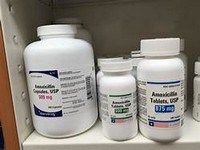Amoxicillin
CLINICAL USE
Antibacterial agent
DOSE IN NORMAL RENAL FUNCTION
250 mg – 1 g every 8 hours (maximum 6 g per
day, up to 12 g in endocarditis)
PHARMACOKINETICS
365.4
20
60
0.3
1–1.5/7–20
DOSE IN RENAL IMPAIRMENT
GFR (mL/MIN)
250 mg – 1 g every 8 hours
(Maximum 6 g per day in
endocarditis)
DOSE IN PATIENTS UNDERGOING RENAL REPLACEMENT THERAPIES
Not dialysed. Dose as in
GFR <10 mL/min
Dialysed. Dose as in GFR
min
Dialysed. Dose as in GFR
min
Dialysed. Dose as in normal renal
function
IMPORTANT DRUG INTERACTIONS
Potentially hazardous interactions with other drugs
ADMINISTRATION
Reconstition
injection; 1 g in 2.5 mL water for injection
or 1% sterile lidocaine hydrochloride
Route
Oral, IV, IM
Rate of Administration
Comments
Stability in infusion depends upon diluent
OTHER INFORMATION
Sodium – 3.3 mmol/g vial of Amoxil
Do not mix with aminoglycosides
